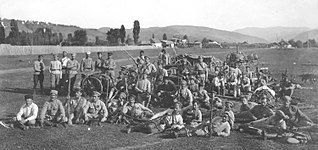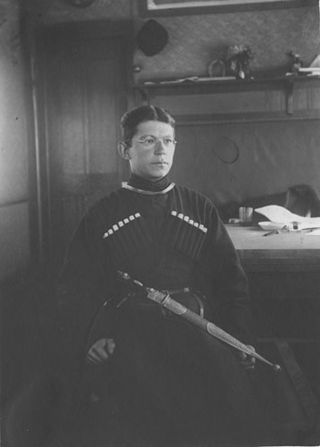
The Russian Civil War was a multi-party civil war in the former Russian Empire sparked by the overthrowing of the social-democratic Russian Provisional Government in the October Revolution, as many factions vied to determine Russia's political future. It resulted in the formation of the Russian Socialist Federative Soviet Republic and later the Soviet Union in most of its territory. Its finale marked the end of the Russian Revolution, which was one of the key events of the 20th century.

Anton Ivanovich Denikin was a Russian military leader who served as the acting supreme ruler of the Russian State and the commander-in-chief of the armed forces of South Russia during the Russian Civil War of 1917–1923. Previously, he was a general in the Imperial Russian Army during World War I.

The White movement, also known as the Whites, was a loose confederation of anti-communist forces that fought the communist Bolsheviks, also known as the Reds, in the Russian Civil War (1917–1923) and that to a lesser extent continued operating as militarized associations of rebels both outside and within Russian borders in Siberia until roughly World War II (1939–1945). The movement's military arm was the White Army, also known as the White Guard or White Guardsmen.

The Mountainous Republic of the Northern Caucasus (MRNC), also referred to as the United Republics of the North Caucasus, Mountain Republic, or the Republic of the Mountaineers, was a short-lived state in Eastern Europe. It encompassed the easternmost portions of the North Caucasus and emerged during the Russian Civil War and existed from 1918 to 1919. It formed as a consolidation of various Caucasian ethnic groups, including the Abazins, Circassians, Chechens, Karachays, Ossetians, Balkars, Ingush, and Dagestanis.

The Sochi conflict was a three-party armed conflict which involved the counterrevolutionary White Russian forces, Bolshevik Red Army and the Democratic Republic of Georgia, each of which sought control over the strategic Black Sea town of Sochi. The conflict was fought as a part of the Russian Civil War and lasted with varying success from June 1918 to May 1919, and ended through British mediation.

The Southern Front was a military theater of the Russian Civil War.
The Polish 4th Rifle Division was a Polish military unit, forming, together with the Polish 5th Rifle Division of the Blue Army, the only part of the Polish military which took part in the Russian Civil War. Under the command of General Lucjan Żeligowski, it operated as an ally of the White movement from autumn 1918 to August 1919 in southern Russia and Bessarabia.

Alexei Ivanovich Avtonomov was a Russian Red Army military commander during the Russian Civil War.

The Volunteer Army (Russian: Добровольческая армия, romanized: Dobrovolcheskaya armiya, abbreviated to Добрармия, Dobrarmiya was a White Army active in South Russia during the Russian Civil War from 1917 to 1920. The Volunteer Army fought against Bolsheviks and the Makhnovists on the Southern Front and the Ukrainian War of Independence. On 8 January 1919, it was made part of the Armed Forces of South Russia, becoming the largest force of the White movement until it was merged with the Army of Wrangel in March 1920.

Ivan Lukich Sorokin Russian: Ива́н Луки́ч Соро́кин; 4 December 1884 – 3 November 1918) was a Russian military leader and participant in the Russo-Japanese War, World War I, and the Russian Civil War. He was Commander-in-Chief of the Red Army of the North Caucasus and Commander of the 11th Red Army.

The Armed Forces of South Russia (AFSR or SRAF) (Russian: Вооружённые силы Юга России, romanized: Vooruzhyonniye sily Yuga Rossii, VSYuR) were the unified military forces of the White movement in southern Russia between 1919 and 1920.

The Battle of Tsaritsyn was a military confrontation between the Red Army and the White Army during the Russian Civil War for control of Tsaritsyn, a significant city and port on the Volga River in southwestern Russia.

The Kuban Offensive, also called the Second Kuban Campaign, was fought between the White and Red Armies during the Russian Civil War. The White Army achieved an important victory despite being numerically inferior in manpower and artillery. It resulted in the capture of Ekaterinodar and Novorossiysk in August 1918 and the conquest of the Western part of Kuban by the White armies. Later in 1918 they took Maykop, Armavir and Stavropol, and extended their authority over the entire Kuban Region.
The North Caucasus Operation was a strategic offensive conducted by the Caucasian Front of the Red Army against the White Armed Forces of South Russia in the North Caucasus region between 17 January and 7 April 1920. It took place on the Southern Front of the Russian Civil War and was a Soviet attempt to destroy White resistance.

Ivan Fyodorovich Fedko was a Soviet Komandarm 1st rank and army commander. He was born in what is now the Left-bank Ukraine. He fought in the Imperial Russian Army during World War I before joining the Bolsheviks. During the Russian Civil War, he fought against the White movement army of Abram Dragomirov in Kiev. He was a 4-time recipient of the Order of the Red Banner and the Order of Lenin. He was made a Komandarm 2nd rank in 1935 and a Komandarm 1st rank on February 20, 1938. In 1938, he was awarded the Jubilee Medal "XX Years of the Workers' and Peasants' Red Army".

During the Russian Civil War of 1917-1923, a number of former Tsarist officers joined the Red Army, either voluntarily or as a result of coercion. This list includes officers of the Imperial Russian Army commissioned before 1917 who joined the Bolsheviks as commanders or as military specialists. For former Tsarist NCOs promoted under the Soviets, see Mustang.

The 11th Army was a field army of the Red Army during the Russian Civil War, which fought on the Caspian-Caucasian Front. It took a prominent part in the sovietization of the three republics of the southern Caucasus in 1920–21, when Azerbaijan, Armenia, and Georgia were brought within the orbit of Soviet Russia.
The 9th Army was a field army of the Red Army during the Russian Civil War which existed from October 3, 1918 until June 22, 1921.

The Northern Caucasus Operation was fought between the White and Red Armies during the Russian Civil War between December 1918 and March 1919. The White Army captured the entire Northern Caucasus. The Red Army withdrew to Astrahan and the Volga delta.
The leaders of the Russian Civil War listed below include the important political and military figures of the Russian Civil War. The conflict, fought largely from 7 November 1917 to 25 October 1922, was fought between numerous factions, the two largest being the Bolsheviks and the White Movement. While the Bolsheviks were centralized under the administration of the Russian Soviet Federative Socialist Republic and the Russian Communist Party (Bolsheviks), led by Vladimir Lenin, along with their various satellite and buffer states, the White Movement was more decentralized, functioning as a loose confederation of anti-Bolshevik forces united only in opposition to their common enemy - though from September 1918 to April 1920, the White Armies were nominally united under the administration of the Russian State, when, for nearly two years, Admiral Alexander Kolchak served as the overall head of the White Movement and as the internationally recognized Head of State of Russia. In addition to the two primary factions, the war also involved a number of third parties, including the anarchists of the Revolutionary Insurgent Army of Ukraine, and the non-ideological Green Armies.
















